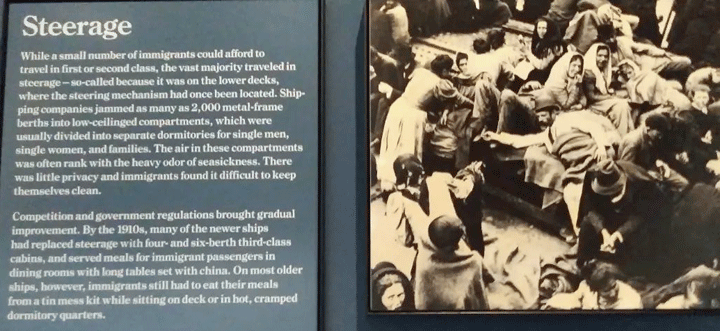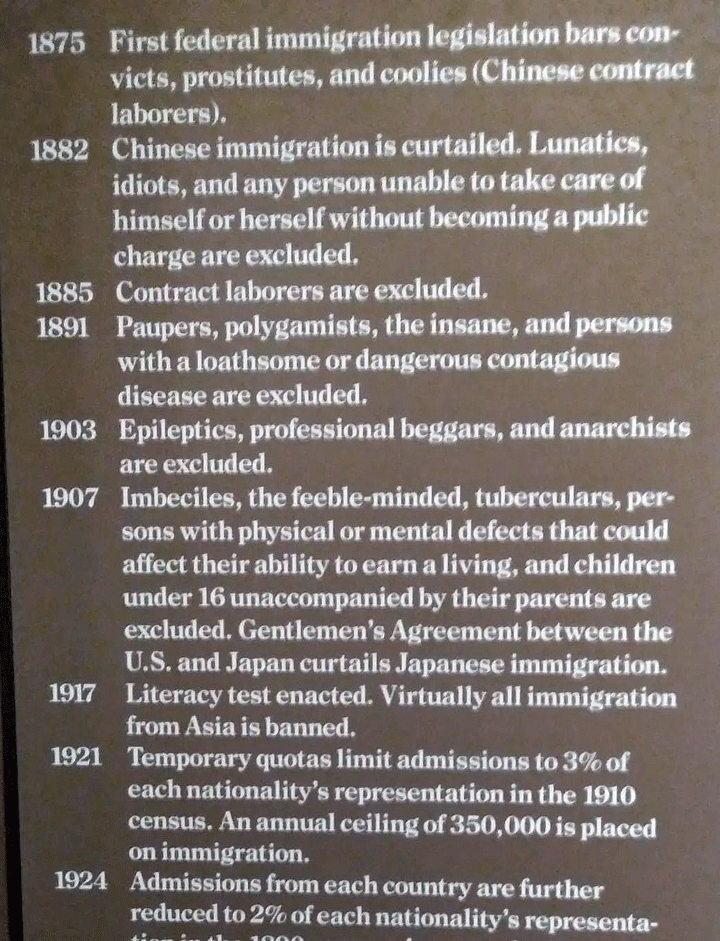Ellis Island has wonderful displays about immigration to America going back to the land bridge; even though it itself was only used from 1892- 1924. Although it did not close until 1954, in those later years it was only used for exceptional cases, since screening was done at the other end.  This came about due to the increased restrictions on immigration (see list at the end of this article), most importantly the National Origins Act of 1924. Click here for the history of Ellis Island and click here for the BBC series of articles “The Open Door policy and immigration to 1928.”
This came about due to the increased restrictions on immigration (see list at the end of this article), most importantly the National Origins Act of 1924. Click here for the history of Ellis Island and click here for the BBC series of articles “The Open Door policy and immigration to 1928.”
The displays at Ellis Island have photos and letters and recorded voices but what struck me the most was the fact that there were so many anti-immigrant demonstrations back in the 19th century. I learned about them from an exhibit on the 2nd floor and thus learned that that sort of sentiment is not new. First it was the Irish immigrants, then the Chinese, then the Southern Europeans, and so on. There was the No Nothing party and the Nativists in the mid 1800s (click here for an article on the Know Nothings). I don’t remember much of this from my high school American history classes. Was it even covered to the extent shown on those walls?
Another fact that I had not known is why the cheapest passage area that my Norwegian ancestors were in was called steerage. Here is that wall display from Ellis Island.
My Munson grandfather wrote my father a series of letters during WWII describing his family’s immigration from Norway. I think that these letters are a true family history treasure. Click here to read my transcription of them.
I am so grateful that I finally visited Ellis Island. My excuse was that I could not find the manifest for a specific ship online anywhere. I needed it for a client case and I had the arrival date and ship name so I was confident I could find it at Ellis Island. At the museum’s family history center I paid a small fee for 20 minutes with their computers. The search app is very good, so I found that passenger list. Now that I have it, maybe I can figure out how I might have found it online. A topic for another blog post!


My great-grandmother brought my three-year old grandmother to the US in 1893 (Schleswig to Denmark to Liverpool to US). Can’t imagine traveling with a young child in steerage (their berths) in seasick cramped quarters. Eventually they made it to Oregon. What guts she had!
Hi Kitty, this looks like a really interesting article, but unfortunately u can’t access the text via the “speak” function on my iPad because for som reason, no matter where in the text I click to begin selecting it before requesting it to be read, it behaves as if I’m selecting an image. Thus, there is no way to invoke the artificial speech function. This is a new phenomenon, only the second time I’ve had this problem on your wonderful blog, so something must have changed recently. As it is now, the only text I can select to read is the comments.
Deborah, I think maybe that happens when the first thing in the article is an image. I have changed that so please try again and let me know if it is fixed.
My parents arrived at Ellis Island on October 1, 1948. They traveled on the USS Queen Elizabeth out of Cherbourg, France. They are listed as in transit to Venezuela, but they had no intention of going there. My mother told me about being separated from her husband, my father, and staying overnight in the women’s section. She came out in the morning and found my father playing ping-pong with the other men. My mother’s uncle posted a bond so they could get off the ship, which he obviously knew, he would lose. They were released to him the next morning. By November, they were in INS deportation hearings. I have copies of those. However, by that time, they were pregnant with me and I got to be an anchor baby!
Early days in one of my ancestor’s towns the newspaper was full of letters to the editor complaining that newcomers were not speaking English. Then it became complaints against famine Irish maids who had no idea how to be indoor servants. A little while later there was nostalgia that no longer was Scots Gaelic spoken in the streets. Later still, that any two people from that town meeting far away had common experiences including a belief in the superiority of their town. The melting pot had welded them all together.
And 150-200 years after some Irish had openly rebelled in another town, government and the administration are full of their descendants. Some of our more recent arrivals have taken only a generation to make a big jump.
During my life I have watched so many immigrant parents sacrifice their working lives for their children’s futures. So noble.